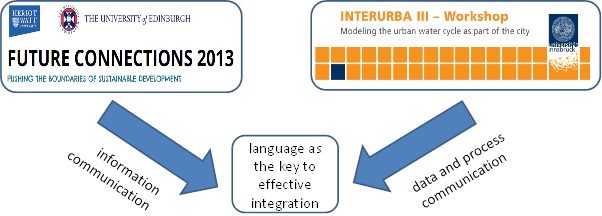
September 2, 2013, by Blue-Green team
Everyone is wondering the same thing…what is the key to integrated multidisciplinary research and modelling?
Deonie Allen, Heriot-Watt University.
There is not yet an established, accepted, and proven method for integrated research and modelling, especially with regards to water sensitive urban design (WSUD), flood risk and urban drainage. However, there are numerous leading edge projects that are working to establish effective methods and processes. The Blue-Green Cities project is on this list…driving effective cross discipline research and modelling to look at flood risk and the urban water cycle in a holistic, interdisciplinary way for effective analysis of the multiple benefits and process driven cycle of impact, change and evolution.
Recently I attended two interdisciplinary workshops, aimed at opposite ends of the research spectrum. The Interurba workshop was a gathering predominantly of established researchers across the stormwater and flooding disciplines. Academics from Universities across Europe, Canada and Australia met in the Austrian mountains to discuss modelling of the urban water cycle as part of the city. This conference was focused on the issues of flood risk and stormwater related modelling that extended to social, economic, scientific and engineering elements, and the difficulties in bringing this highly varied information together in an informed and effective way. The second workshop was a sustainable development forum for PhD and early researchers. This great two day workshop involved 40 young researchers across the UK meeting to discuss their inroads and difficulties in interdisciplinary research. The 2013 FutureConnections workshop was hosted at Edinburgh University and provided a platform to exchange research information, methods to successfully achieve interdisciplinary research and to discuss the ins and outs, benefits and constraints, hurdles and complexities. Key questions raised included:
- Agent based modelling vs. integrated super models: What is the right level of complexity and acceptable level of uncertainty? How do we effective interface empirical quantitative data and analysis with qualitative information?
- Predictive vs. explanatory: What are we trying to achieve? Do we want to try and replicate the existing integrated processes or to forecast/predict how an integrated process might function/outcomes/impacts may result in the future or due to possible input changes?
- Uncertainty: is this a positive tool for change or an issue that needs to be quantified and solved? Is transition modelling effective when considering engineered and physical systems, as well as social processes?
The FutureConnections discussions emphasised the difficulty in on-the-ground integrated research, specifically the differences in language, methodology, emphasis on process vs. results and the definition of a valued outcome/achievement. Clear definition of aim, jointly understood and defined, but all facets of the research team, is highly important. It was found that grouping discipline specialists to complete multiple mini, disconnected projects, collating and collecting these project outcomes them at the end, is relative ineffective. Every academic stakeholder and participant ideally needs to understand the discipline linkages and research question, and agree on the aim of the overall and sub-research project. In essence, breaking the silos.
No comments yet, fill out a comment to be the first


Leave a Reply